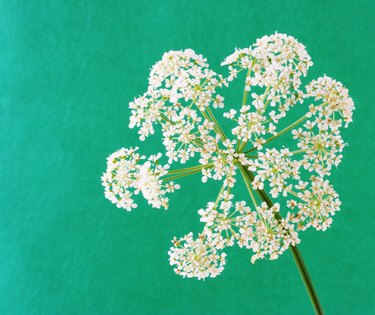
Bishop's weed (Aegopodium podagraria), sometimes called goutweed, came to the U.S. with the early European settlers as an ornamental plant. This herbaceous perennial grows in U.S. Department of Agriculture plant hardiness zones 4 through 9. Although a drought- and shade-tolerant, attractive ground cover with its green to blue-green leaves and white, summer-blooming flowers, bishop's weed also has long, branching rhizomes that grow quickly and allow the plant to spread aggressively. This plant is considered invasive in several northeastern states. Prevent bishop's weed from taking over your yard with a number of methods.
Manual Methods
Video of the Day
Hand weeding or grubbing out unwanted bishop's weed plants can effectively control small patches of the plant, but make sure you remove all of the underground roots. Even a tiny piece of rhizome can sprout and grow into a new plant. Make the weeding process easier by first moistening the soil with a garden hose and then loosening the dirt with a trowel. Grub out bishop's weed using a shovel or garden spade. Begin digging about 12 inches away from the main plant to help loosen up the soil. Repeat the digging or pulling process when new bishop's weed plants appear. Pile up bishop's weed debris on a tarp and allow it to dry for several days before disposing of the remains. Do not place the weeds on your compost heap or rhizome pieces could resprout.
Video of the Day
Physical Control
Prevent bishop's weed from spreading across your yard by covering patches with thick black plastic sheets in the early spring when the plants start leafing out. The black plastic stops sunlight from reaching the plant, which prevents it from photosynthesizing and growing. First, wet the soil at least 1 foot deep around the unwanted weeds, because damp soil conducts heat better than dry soil. Lay a plastic sheet over the damp soil and weight down the edges with rocks, bricks or sandbags. Leave the black plastic on the area throughout the summer to kill the rhizomes.
Chemical Treatments
Glyphosate-based herbicides most effectively control large patches of bishop's weed. Spray this systemic herbicide on the leaves and the chemicals work their way down to the roots to kill the whole plant. Read and follow the instructions on the product's label because directions will vary. One product suggests mixing 5 tablespoons of glyphosate for every 1 gallon of water into a garden sprayer. Spray the foliage of actively growing bishop's weed plants until the foliage glistens with moisture. Follow up with another application if the weeds don't die within four weeks. Spray weeds only on warm, calm days when no rain is expected for at least 24 hours after treatment. Reapply if it rains within 24 hours.
Glyphosate Warnings
Avoid getting glyphosate on desirable plants, because this herbicide will kill any plant it touches. Lay cardboard or plastic over the plants you want to keep before spraying to shield them. If the spray drifts on desirable plants, promptly rinse off the herbicide with a garden hose. Glyphosate can cause irritation if you get it on your skin or in your eyes. Protect yourself from potential exposure by wearing goggles, a face mask, waterproof gloves, long sleeves, long pants and shoes with socks. Keep children and pets out of the treatment area until the spray dries.
- Plant Conservation Alliance's Alien Plant Working Group: Least Wanted: Goutweed
- University of California Statewide Integrated Pest Management Program: Soil Solarization for Gardens & Landscapes
- Iowa State University Extension: Ask the ISU Extension Gardening Experts
- Fine Gardening: Here Are Some Proven Methods for Controlling Weeds in Your Garden
- The Nature Conservancy: Invasive Fact Sheet -- Goutweed
- Missouri Botanical Garden: Aegopodium Podagraria "Variegatum"
- USDA Forest Service: Weed of the Week: Goutweed
- University of Florida IFAS Extension: Nonchemical Weed Control for Home Landscapes and Gardens